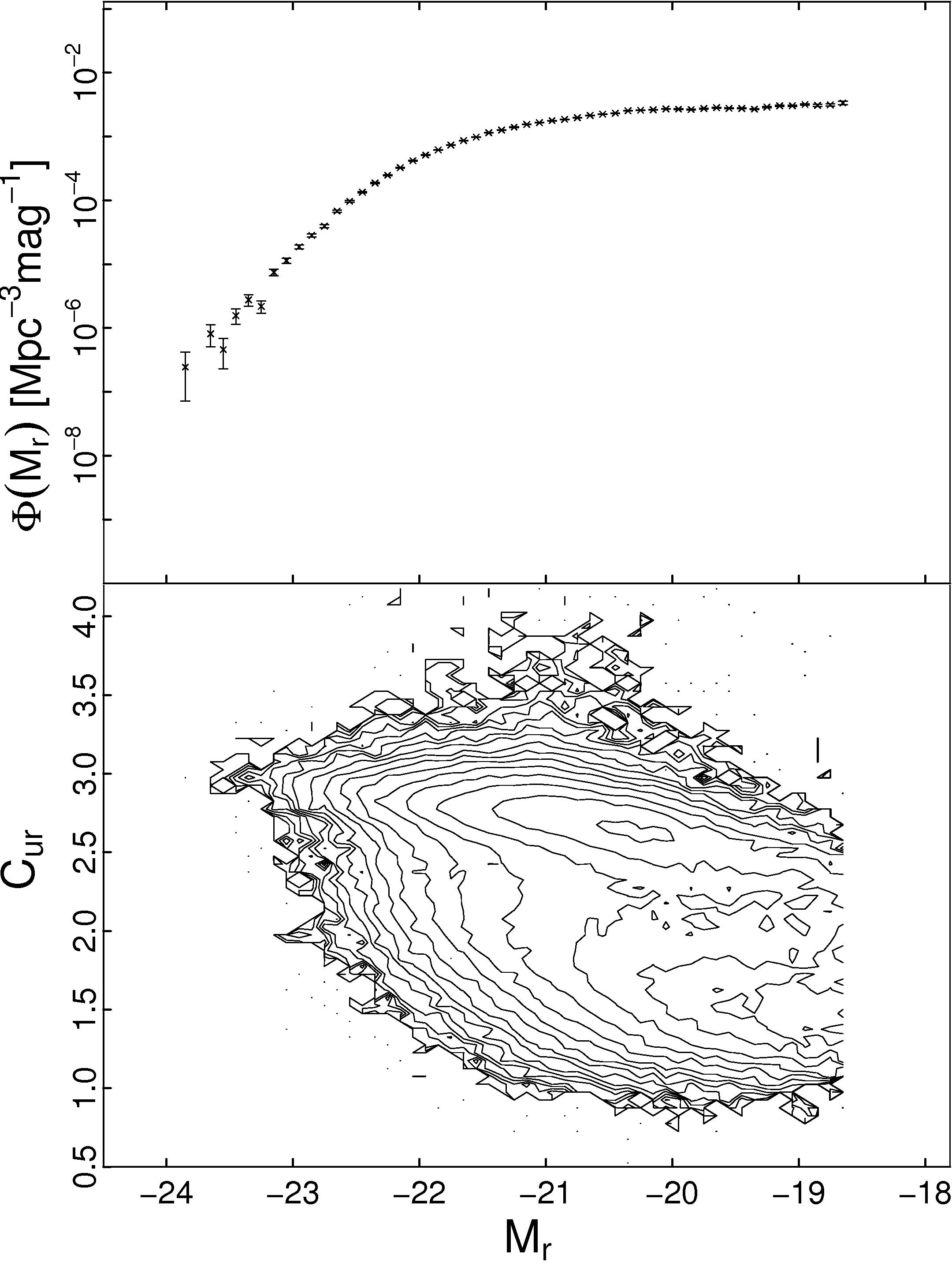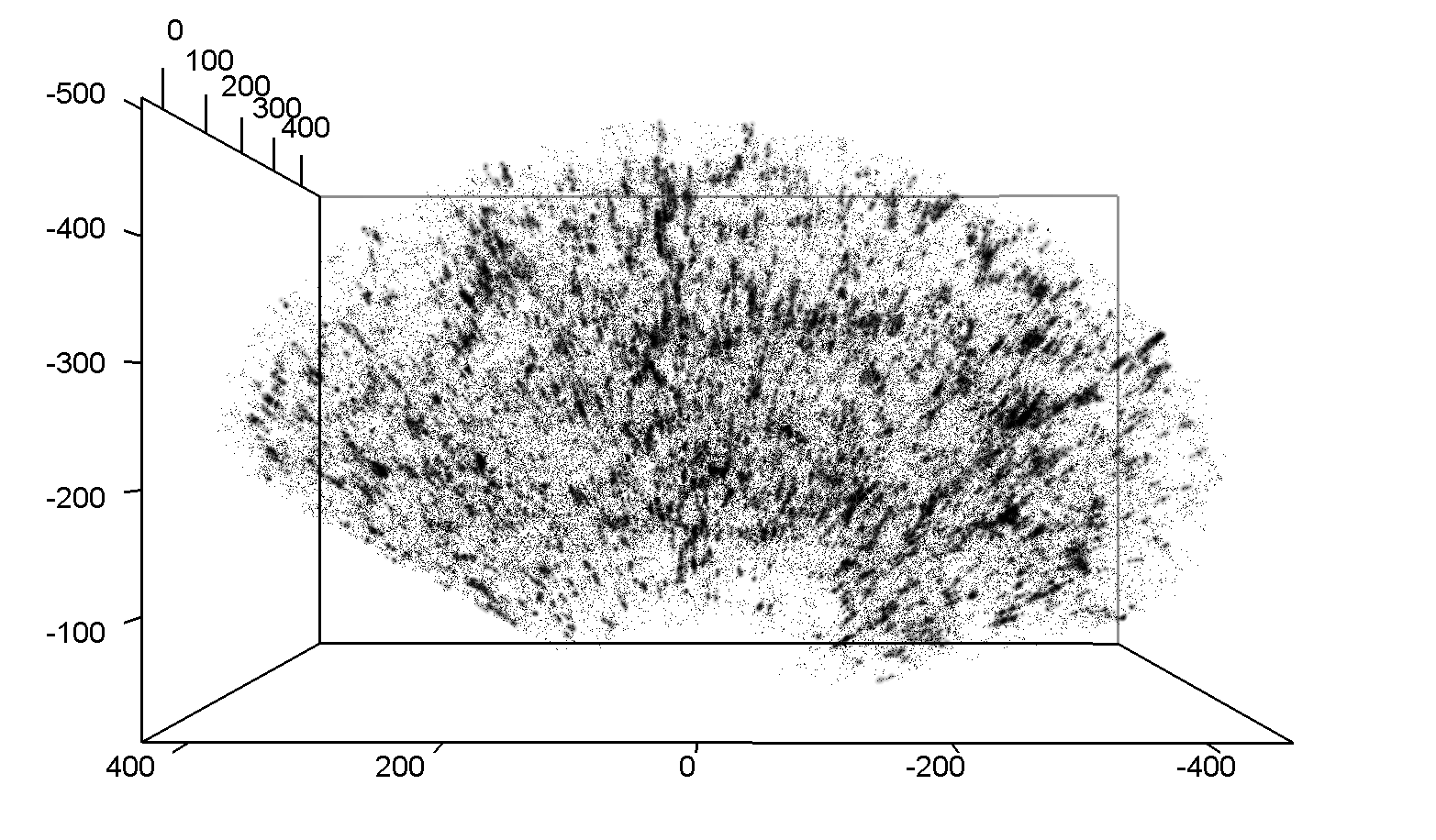
Luminosity Function (top) and Color-Magnitude Diagram (bottom) constructed by running the below T-SQL script.
These examples can be run in CasJobs, accesing SDSS data from BestDR7 database, where

--Calculating the spectroscopic survey area::
SELECT SUM(area) FROM BestDR7..Region
WHERE type='SECTOR' -- AreaSurvey = 7932.12522550822 = 7932.125 SqDeg
--Setting up the redshift, luminosity distance and apparent magnitude cuts:
DECLARE @z_1 float, @z_2 float, @Dlum_1 float, @Dlum_2 float, @m1im_1 float, @mlim_2 float,
@FracVolume float, @AreASurvey float, @Vsurvey float
SET @z_1 = 0.04;
SET @z_2 = 0.12;
SET @Dlum_1=dbo.fCosmfDl(@z_1); print @Dlum_1
SET @Dlum_2=dbo.fCosmfDl(@z_2); print @Dlum_2
SET @m1im_1 = 13.50
SET @mlim_2 = 17.77
-- The fraction of the entire sky volume occupied by the survey footprint:
SET @FracVolume = 0.1922801 -- @FracVolume = AreaSurvey / ( 4*PI()*power((180/PI()),2) )
-- Creating small table with galaxy sample:
CREATE TABLE DR7small(
SpecObjID bigint primary key not null, RA float not null, DEC float not null, z float not null,
m_r float not null, Vmax float not null, Color_u_r float not null
)
INSERT DR7small
SELECT
specobjid, ra, dec, z, petromag_r-extinction_r as m_r,
(dbo.fCosmfComovVolumeFromDl(
CASE
WHEN @Dlum_2 < dbo.fcosmfDl(z)*POWER(10.0,(@mlim_2-(petromag_r-extinction_r))/5.0)
THEN
@Dlum_2
ELSE
dbo.fcosmfDl(z)*POWER(10.0,(@mlim_2-(petromag_r-extinction_r))/5.0)
END)-
dbo.fCosmfComovVolumeFromDl(
CASE
WHEN @Dlum_1 > dbo.fcosmfDl(z)*POWER(10.0,(@m1im_1-(petromag_r-extinction_r))/5.0)
THEN
@Dlum_1
ELSE
dbo.fcosmfDl(z)*POWER(10.0,(@m1im_1-(petromag_r-extinction_r))/5.0)
END) )*@FracVolume AS Vmax,
(modelMag_u-extinction_u)-(modelMag_r-extinction_r) AS Color_u_r
FROM BestDR7.dbo.specphoto
WHERE
z between @z_1 and @z_2
and primtarget&(64|128|256)!=0 -- This chooses the MGS galaxies
and petromag_r-extinction_r between @m1im_1 and @mlim_2
--add your custom photometric and spectroscopic constraints here.
-- Getting the Luminosity function and its error.
-- Absolute magnitude range is [-25,-15], with number of bins = 100
-- (bin size DeltaM = 0.1 magnitudes)
SELECT dbo.fMathBin(v.AbsMag_r,-25, -15, 100 ,1, 1) AS AbsMag,
sum(1/v.Vmax)/0.1 AS Phi,
sqrt(sum( 1/(v.Vmax*v.Vmax) ) )/0.1 AS PhiError,
count(*) AS counts
FROM ( SELECT dbo.fCosmfAbsMag(m_r,z) AS AbsMag_r, Vmax FROM DR7small) AS v
GROUP BY dbo.fMathBin(v.AbsMag_r,-25, -15, 100 ,1, 1)
ORDER BY dbo.fMathBin(v.AbsMag_r,-25, -15, 100 ,1, 1)
-- This gets the same luminosity function as a probability distribution, i.e.,
-- The area under it is unity.
EXECUTE spMathHistogramNDim 'SELECT dbo.fCosmfAbsMag(m_r,z), 1.0/(Vmax) FROM DR7small'
,1, '-25', '-15', '100' ,1
-- This gets the color magnitude diagram as a probability distribution, i.e.,
-- The area under it is unity. The color range is [0,5] with number of bins = 100.
EXECUTE spMathHistogramNDim 'SELECT dbo.fCosmfAbsMag(m_r,z),Color_u_r, 1.0/Vmax FROM DR7small'
,2, '-25,0', '-15,5', '100,100' ,1

--This table stores spatial information:
CREATE TABLE DR7smallLSS(
SpecObjID bigint not null, RA float not null, DEC float not null, z float not null,
Gx float not null, Gy float not null, Gz float not null
--If native MS-SQL server 2008 geospatial indexing is also wanted, add the following line:
--,GeographyCol geography not null
)
-- This creates a unique clustered index or primary key with spatial information:
ALTER TABLE DR7smallLSS ADD PRIMARY KEY (Gx,Gy,Gz,SpecObjID);
INSERT DR7smallLSS
SELECT
specobjid, ra, dec , z,
-- The following gets the midpoints of the 3-dimensional grid cells. Note that
-- the cell side length is rounded to 7Mpc, having 80 cell divisions per dimension.
dbo.fMathBin(dbo.fCosmfDc(z)*SIN(radians(90.0-dec))*COS(radians(RA)),0,560,80,1,1),
dbo.fMathBin(dbo.fCosmfDc(z)*SIN(radians(90.0-dec))*SIN(radians(RA)),0,560,80,1,1),
dbo.fMathBin(dbo.fCosmfDc(z)*COS(radians(90.0-dec)),0,560,80,1,1)
--If native SQL 2008 server geospatial indexing is also wanted, add the following line:
--,GEOGRAPHY::Point(dec,ra,4326) -- 4326 is the SRID number of a custom Earth shape definition.
FROM DR7small
--Add the following line if a volume limited sample is wanted
--WHERE (dbo.fCosmfComovingVolume(0.12)-dbo.fCosmfComovingVolume(0.04))*0.1922801 <= Vmax
ORDER BY
dbo.fMathBin(dbo.fCosmfDc(z)*SIN(radians(90.0-dec))*COS(radians(RA)),0,560,80,1,1),
dbo.fMathBin(dbo.fCosmfDc(z)*SIN(radians(90.0-dec))*SIN(radians(RA)),0,560,80,1,1),
dbo.fMathBin(dbo.fCosmfDc(z)*COS(radians(90.0-dec)),0,560,80,1,1), specObjID
-- This creates the Neighbors table:
CREATE TABLE NeighborsLSS(
SpecObjID bigint not null, NeighborSpecObjID bigint not null
)
CREATE unique clustered index SpecObjIDNeighborSpecObjID ON
NeighborsLSS(SpecObjID,NeighborSpecObjID)
INSERT NeighborsLSS
SELECT h1.Specobjid, h2.SpecObjID
FROM DR7smallLSS as h1, DR7smallLSS as h2
WHERE
-- The value 7.1 Mpc intead of 7 Mpc is chosen to avoid eventual problems with rounding:
h2.Gx between h1.Gx - 7.1 and h1.Gx + 7.1 and
h2.Gy between h1.Gy - 7.1 and h1.Gy + 7.1 and
h2.Gz between h1.Gz - 7.1 and h1.Gz + 7.1 and
-- If native SQL 2008 server geospatial indexing is also wanted,
-- erase the previous 3 lines and add the following line:
-- h1.GeographyRaDec.STDistance(h2.GeographyRaDec) <= (6360000.0)*0.00794
-- Note that 6360000 is a custom Earth radius in meters, and 0.00794 radians is the angular size
-- distance of 1.288 Mpc at redshift 0.04
and
-- The following defines the cylindrical volume around the galaxies:
(dbo.fCosmfDc(h1.z) + dbo.fCosmfDc(h2.z)) *
SIN(dbo.fMathAngSepRADEC(h1.ra,h1.dec,h2.ra,h2.dec)/2.0) <= 1.288 and -- Transverse
ABS(dbo.fCosmfDc(h1.z)-dbo.fCosmfDc(h2.z)) <= 6.902 and -- Line of sight
h1.Specobjid != h2.SpecObjID
GROUP BY h1.Specobjid,h2.SpecObjID
ORDER BY h1.Specobjid,h2.SpecObjID
GO
IF OBJECT_ID('Groups') IS NOT NULL DROP TABLE Groups
IF EXISTS (SELECT name FROM tempdb..sysobjects WHERE name like '#temp%')
DROP TABLE #temp
IF EXISTS (SELECT name FROM tempdb..sysobjects WHERE name like '#Remaining%')
DROP TABLE #Remaining
IF EXISTS (SELECT name FROM tempdb..sysobjects WHERE name like '#PreviousNeighbors%')
DROP TABLE #PreviousNeighbors
IF EXISTS (SELECT name FROM tempdb..sysobjects WHERE name like '#Neighbors%')
DROP TABLE #Neighbors
IF EXISTS (SELECT name FROM tempdb..sysobjects WHERE name like '#NewNeighbors%')
DROP TABLE #NewNeighbors
CREATE TABLE Groups(
SpecObjID bigint not null, GroupID int not null
)
-- This finds and labels into groups the galaxies that have no neighbors:
SELECT SpecObjID,IDENTITY(int,1,1) AS GroupID INTO #temp FROM DR7smallLSS
WHERE SpecObjID NOT IN (SELECT SpecObjID FROM NeighborsLSS)
ORDER BY SpecObjID
INSERT Groups SELECT * FROM #temp
DROP TABLE #temp
GO
-- #Remaining has the galaxies that have not been yet labeled:
CREATE TABLE #Remaining(SpecObjID bigint primary key not null)
INSERT #Remaining SELECT specobjid FROM DR7smallLSS
WHERE SpecObjID NOT IN (SELECT SpecObjID FROM Groups) ORDER BY SpecObjID
-- #Neighbors stores the neighboring galaxies of the ones in table #PreviousNeighbors, and
-- #NewNeighbors stores the neighboring galaxies of the ones in table #Neighbors that
-- are not in table #PreviousNeighbors
CREATE TABLE #PreviousNeighbors(SpecObjID bigint not null)
CREATE TABLE #Neighbors(SpecObjID bigint not null)
CREATE TABLE #NewNeighbors(SpecObjID bigint not null)
--SET NOCOUNT ON
-- Starting the FoF algorithm:
DECLARE @SpecObjID bigint
DECLARE @i int, @counts int
-- @i stores the group label:
SELECT @i=COUNT(*)+1 FROM Groups
-- Getting the first galaxy:
SELECT TOP 1 @SpecObjID= specobjid FROM #Remaining
INSERT #PreviousNeighbors SELECT @SpecObjID
-- Finding the neighbors:
INSERT #Neighbors SELECT NeighborSpecObjID FROM NeighborsLSS WHERE SpecObjID = @SpecObjID
-- labeling the group:
INSERT Groups SELECT @SpecObjID,@i
--Updating #Remaining:
DELETE FROM #Remaining WHERE SpecObjID=@SpecObjID
--Starting the loop that finds new neighbors:
WHILE 1=1
BEGIN
TRUNCATE TABLE #NewNeighbors
-- Getting the new neighbors of the neighbors:
INSERT #NewNeighbors
SELECT n1.NeighborSpecObjID
FROM NeighborsLSS as n1 JOIN #Neighbors n2 on n1.SpecObjID=n2.SpecObjID
WHERE n1.NeighborSpecObjID NOT IN
(SELECT SpecObjID FROM #PreviousNeighbors UNION SELECT SpecObjID FROM #Neighbors)
GROUP BY n1.NeighborSpecObjID
SELECT @counts = COUNT(*) FROM #NewNeighbors
IF (@counts>=1)-- If there are new neighbors, label current the group members and set the new neighbors
-- as the current neighbors:
BEGIN
INSERT Groups
SELECT SpecObjID, @i FROM #Neighbors
DELETE FROM #Remaining WHERE SpecObjID in (SELECT SpecObjID FROM #Neighbors)
TRUNCATE TABLE #PreviousNeighbors
INSERT #PreviousNeighbors SELECT SpecObjID FROM #Neighbors
TRUNCATE TABLE #Neighbors
INSERT #Neighbors SELECT SpecObjID FROM #NewNeighbors
END
ELSE -- If there are no new neighbors, store the group label and start with new galaxy:
BEGIN
INSERT Groups
SELECT SpecObjID, @i FROM #Neighbors
DELETE FROM #Remaining WHERE SpecObjID in (SELECT SpecObjID FROM #Neighbors)
SET @i=@i+1
SELECT TOP 1 @SpecObjID = specobjid FROM #Remaining
-- If all galaxies have been labeled, stop:
IF NOT EXISTS (select top 1 specobjid from #Remaining)
BREAK -- this exists the while loop
TRUNCATE TABLE #PreviousNeighbors
INSERT #PreviousNeighbors SELECT @SpecObjID
TRUNCATE TABLE #Neighbors
INSERT #Neighbors SELECT NeighborSpecObjID FROM NeighborsLSS WHERE SpecObjID = @SpecObjID
INSERT Groups SELECT @SpecObjID,@i
DELETE FROM #Remaining WHERE SpecObjID=@SpecObjID
END
END